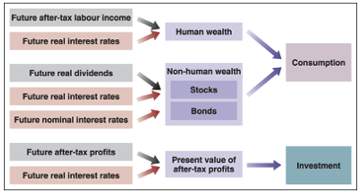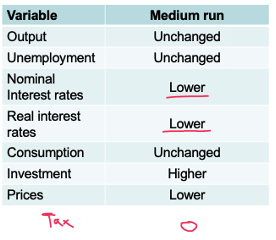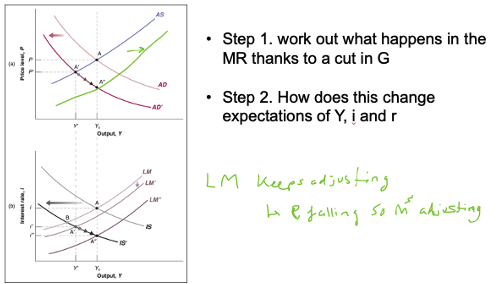Macro Topic E - Expectation
1/28
Earn XP
Description and Tags
Name | Mastery | Learn | Test | Matching | Spaced |
|---|
No study sessions yet.
29 Terms
C and expectations
Previously assumed C depends on disposable income (c0) and MPC (c1)
Now C depends on total wealth → Ct = C
what makes up total wealth
Total wealth = human wealth + non-human wealth
Human wealth
expected present value of after-tax current and future labour income
Wealth depends on current taxes / income and how you expect taxes / income to be in the future
Non - human wealth
financial wealth + housing wealth
financial wealth
the value of stocks and bonds + the value of savings
Housing wealth
Value of house - mortgage left
Total wealth theory of C
Individuals smooth shocks to income across their lifetimes
if they can correctly anticipate the future
C in reality
C reacts to current changes in income
Individuals incorrectly judge expectations about the future
Individuals are financially constrained
How do expectations affect C
Directly - Human wealth & Indirectly - Non-human wealth
If the consumer decides the decrease in income is permanent / transitory, they are likely to decrease consumption one-for-one / less than 1-1
Consumption may move even if current income does not change due to changes in consumer confidence
How expectations directly affect C
expectations of future labour income, real interest rates and taxes change
How expectations indirectly affect C
Financial markets & i play a role
I & expectations
I depends on Y + r & Ye + re → Investing in K depends on expected profits and current costs
I depends positively on Ye & negatively on re
AD and expectations

i now affects C
re affects Human + non-human wealth + I

Increase in Current and expected future post tax real labour income
increase HW → C increases
Increase in current and expected future real dividends
stock prices UP → increase NHW → C increases
decrease in r & re
increase HW → C increases
&
stock prices UP → increase NHW → C increases
&
Present values of real after tax profits UP → I increases
Decrease in i & ie
Bond prices UP → NHW increase → C increases
Increase in current and expected future real after tax profits
Present values of real after tax profits UP → I increases
IS and expectations
Downwards sloping
Steeper - changes in current r not only determinant of I
Increase in G or Ye → Shift right
Increase in T, Te or ie → shift left
Multiplier under expectations
changes in current r have smaller impact in present
IF they dont change expectations
Expectations and AD-AS
Expectations only affect SR
FP - G decrease - NO EXPECTATIONS


FP - G decrease - EXPECTATIONS
Y = Ye & T = Te r & i are different to re & ie
i & r fall → HW + NHW +I rise
AD shifts after initial AD fall

Austerity plans and current effects
Back loading - Expected cuts in G will increase Y in current
works unless cuts aren’t credible if deficit reduction programme doesn’t look good
Govt must play balancing act - enough cuts in current to show commitment to deficit reduction + enough cuts left to future to reduce adverse effects on economy in SR.
Negative AS shock - NO EXPECTATIONS


Negative AS shock - EXPECTATIONS
Ye falls ie & re rise Te unchanged - exogenous
Y + p + i fall & u rises

Expectations & static vs dynamic model
in MR:
Static → Y i r T unchanged
Dynamic → i affected so ie changes ∆ gm = ∆π = ∆i
Expansionary MP + expectation in DYNAMIC MODEL
Expansionary MP →∆gm increase → i increase → ie increase → AD shifts inwards

Back loading
Expected cuts in G will increase Y in current